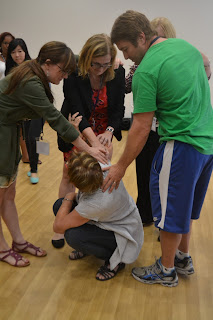Blogging for Wheelock Conference" 2013 Global Challenges and Opportunities"
I participated in many conferences around the world but I found Wheelock Conference unique since its kick off.
The opening panel of the conference celebrated art as a window and a mirror to the world. Ellie Friedland, the associate professor on Early Childhood Education at Wheelock College, stated that every act is a political statement, “starting this conference with an Art Panel is political.” The panelists discussed arts’ integration between praxis and critical consciousness, multiple intelligence by Howard Gardner, performance in scenes and monologue, connecting art to science and maths, theatre as a different place from school and teachers’ engagement and passion. They all emphasized training the awareness and interpersonal creativity of the child. John Bay drew a conclusion after an exercise he shared with the audience, that “we need a mixture of the strange and the familiar because too strange is scary and too familiar is boring.” He also did another exercise on the geometry of the conversation by playing with angles, tones and mathematical elements while keeping the same language. Seet Fun Wong, an art teacher in Singapore, shared her experience of the use of museums and galleries for children’s learning. “Children are shy to express themselves because they’re afraid to make mistakes,” she says. Owusu, on the other hand, brought the role of digital media into the discussion by questioning digital immigrants versus digital natives and the need to media literacy education in the learning to empower the students. She also called on the shift in the use of media consciously and mindfully. Lavina Chong, the founder and director of Our Music Classroom Pte Ltd, Singapore, explained the steady beat as a learning behavior. She stressed the benefits of steady beat for children which help them develop observation skills, concentration, active listening, discipline, non-violence, memorization, control of the movement over period of time repeatedly and consistently, “which is all you need to make a child successful personally and academically,” as she expressed.
The conversation was extremely interesting and I eventually asked a question of the panel. “How can we use art for children in conflict zones for healing without engendering an opposite outcome of depression, memories and isolation?” Ellie reacted, in fact, to my question by stating that “we are the facilitators to make the environment safe, not the participants safe, by using appropriate methods to make them heal. As leaders we have to take responsibility of the group and ensure their self-expression and we should sometimes pause and listen”
The overall consensus of the panel through different artistic expression was that “to lead a human being to master himself and his relationship is to educate him.”
During the afternoon, the panelists translated their words into practical workshops of Drama, Music and Media. The observation I could make during these workshops can be summed up into three main points; the very creative dynamics created during these workshops, the age and intergenerational dialogue, and, the diversity and multicultural learning environment. I guess the pictures can speak for themselves.

This post is also published at Wheelock Conference Website













Comments